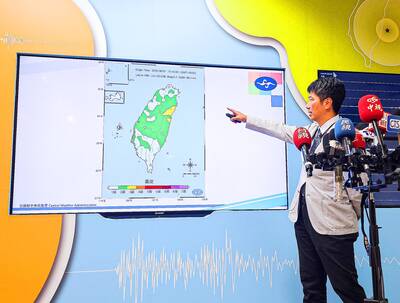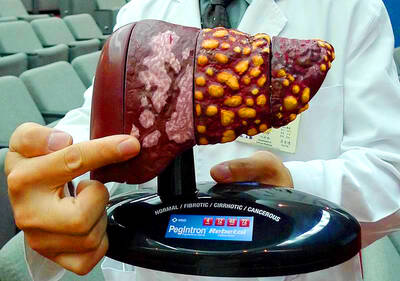Antibiotic resistance has become a serious public health issue in Taiwan at a time when the nation could soon face the possibility of running out of effective antibiotics to treat infections, infectious disease experts said yesterday.
“The global threat of antibiotic resistance has impacted not only the international community, but also Taiwan,” Infection Control Society of Taiwan president Wang Fu-der (王復德) said at a press conference in Taipei.
He said more antibiotic drugs should be developed domestically or the domestic healthcare system should pay higher drug prices to entice foreign pharmaceutical companies to make their more advanced antibiotics available in Taiwan.

Photo: Chiu jou, Taipei Times
Although Wang was not able to quantify the current or near-term threat created by bacterial resistance to antibiotics, he cited studies estimating that antibiotic resistance could cause up to 33,000 deaths and economic losses of NT$300 billion (US$10.02 billion) in Taiwan in 2050.
One particular threat that has already arisen in Taiwan was carbapenem-resistant Enterobacteriaceae (CRE) group of bacteria commonly used in hospitals across the nation, Wang said.
CRE was one of the most critical threats that appeared on the WHO’s updated Bacterial Pathogen Priority List last year, he added.
Citing data from the Centers for Disease Control, Wang said that 30.3 percent of intensive care unit patients were infected with CRE in the third quarter of last year, up from 15 percent in 2015.
The rising figure, along with other indicators, showed that Taiwan is facing “a serious antibiotic resistance problem,” he said.
Infectious Diseases Society of Taiwan president Chang Feng-yee (張峰義) said that only a few antibiotics remain available as last-line treatment options in Taiwan, which are insufficient to meet clinical and patient needs.
Treating infections caused by multidrug-resistant bacteria requires new antibiotics, but Taiwan has fewer treatment options available compared with Western countries, which presents “a major challenge,” he said.
“Delayed treatment for drug-resistant bacterial infections can lead to higher mortality, with studies showing a sharp increase in death rates if appropriate antibiotics are not given within 72 hours,” Chang said.
Wang said the government should support local pharmaceutical companies in developing new antibiotics, as most are focused on generic drugs and lack the capacity for original antibiotic research and development.
Introducing new antibiotics developed overseas is also a solution, but Taiwan’s relatively low drug prices — mainly regulated by the National Health Insurance (NHI) system — have discouraged international drug companies from entering the Taiwanese market, he said.
“Taiwan is considered a relatively small market, so most companies prioritize entering the Chinese market first, where drug prices tend to be more favorable than in Taiwan,” he added.
Chang said that the NHI system is internationally known for its “strong bargaining power” with pharmaceutical companies, meaning it tends to drive down drug prices to maximize cost-effectiveness.
If pharmaceutical companies were to accept a low price in Taiwan, it could lead to pressure to lower prices in other countries as well, Chang said, adding that many companies are unwilling to bring new antibiotics to the Taiwanese market.
“Many companies would rather give up the Taiwanese market, which is why having reasonable NHI drug prices are so important,” he said.

The Taipei Summer Festival is to begin tomorrow at Dadaocheng Wharf (大稻埕), featuring four themed firework shows and five live music performances throughout the month, the Taipei Department of Information and Tourism said today. The festival in the city’s Datong District (大同) is to run until Aug. 30, holding firework displays on Wednesdays and the final Saturday of the event. The first show is scheduled for tomorrow, followed by Aug. 13, 20 and 30. To celebrate the 30th anniversary of Disney Pixar's movie Toy Story, the festival has partnered with Walt Disney Co (Taiwan) to host a special themed area on

Aftershocks from a magnitude 6.2 earthquake that struck off Yilan County at 3:45pm yesterday could reach a magnitude of 5 to 5.5, the Central Weather Administration (CWA) said. Seismological Center technical officer Chiu Chun-ta (邱俊達) told a news conference that the epicenter of the temblor was more than 100km from Taiwan. Although predicted to measure between magnitude 5 and 5.5, the aftershocks would reach an intensity of 1 on Taiwan’s 7-tier scale, which gauges the actual effect of an earthquake, he said. The earthquake lasted longer in Taipei because the city is in a basin, he said. The quake’s epicenter was about 128.9km east-southeast

BE CAREFUL: The virus rarely causes severe illness or death, but newborns, older people and those with medical conditions are at risk of more severe illness As more than 7,000 cases of chikungunya fever have been reported in China’s Guangdong Province this year, including 2,892 new cases last week, the Centers for Disease Control (CDC) yesterday said it is monitoring the situation and considering raising the travel notice level, which might be announced today. The CDC issued a level 1 travel notice, or “watch,” for Guangdong Province on July 22, citing an outbreak in Foshan, a manufacturing hub in the south of the province, that was reported early last month. Between July 27 and Saturday, the province reported 2,892 new cases of chikungunya, reaching a total of 7,716

STAY VIGILANT: People should reduce the risk of chronic liver inflammation by avoiding excessive alcohol consumption, smoking and eating pickled foods, the physician said A doctor last week urged people to look for five key warning signs of acute liver failure after popular producer-turned-entertainer Shen Yu-lin (沈玉琳) was reportedly admitted to an intensive care unit for fulminant hepatitis. Fulminant hepatitis is the rapid and massive death of liver cells, impairing the organ’s detoxification, metabolic, protein synthesis and bile production functions, which if left untreated has a mortality rate as high as 80 percent, according to the Web site of Advancing Clinical Treatment of Liver Disease, an international organization focused on liver disease prevention and treatment. People with hepatitis B or C are at higher risk of